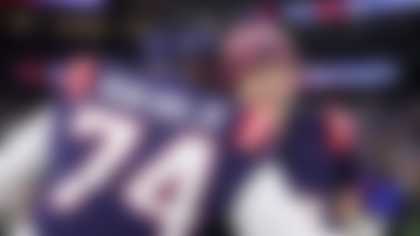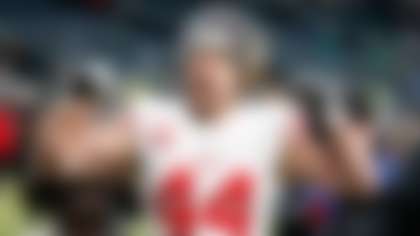Back in December, when Commissioner Roger Goodell announced he had asked a group of former coaches, team executives and players to study the catch rule, the hope among fans was that a simpler, more easily-understandable rule would emerge.
That is not how things turned out.
New York Giants president John Mara, a member of the Competition Committee, and Dean Blandino, the league's head of officiating, said this week that they do not expect the catch rule -- a source of nearly weekly questions and commentary during the season -- to change at all. And Bill Polian, the former Indianapolis Colts general manager who is a member of the catch-rule committee, said meetings of that committee revealed that most people who work in football, including the coaches and most players, already understand what a catch is, especially when they are shown replays.
"Nothing has been finalized, but my sense is that there will be no change to the rule or tweak of the language," Blandino said in an email. "We will certainly continue to use video to educate in this area."
The Competition Committee will grapple with other issues, including the idea Goodell floated at his Super Bowl week press conference that a player with multiple personal fouls should automatically be ejected. Goodell's revelation of the idea caught some by surprise, but there is some support for the concept. Mara said lengthy conversations this week have centered on which personal fouls would qualify a player for ejection.
"That has a lot of issues associated with it," Mara said. "What is the list of personal fouls that will qualify for a player to be ejected? Do we want to eliminate personal fouls and just make it for unsportsmanlike conduct? What we want to avoid is a situation where a guy grabs a facemask and that's the second personal foul and he gets ejected. Or if he is going to block a pass and he hits the quarterback's head, and that's the second personal foul. It gets to be a very tricky discussion, and I don't think we're close to a resolution."
Mara said he has raised the question of what the league is trying to eliminate with such a rule -- would it be the out-of-control behavior of Odell Beckham Jr. and Josh Norman during their showdown in the regular season? Officials already have the power to eject players, although they have been hesitant to use it. If the committee cannot come up with an entirely new rule, it is possible a point of emphasis could be created in which officials are shown the Beckham-Norman game and told that if they encounter such a situation, they should eject both players.
But ever since a potential game-winning touchdown catch by the Detroit Lions' Calvin Johnson was ruled incomplete back in 2010, no rule has captivated and confounded fans and the media like the catch rule. Last year, the Competition Committee tweaked the wording of the rule in an attempt to clarify it -- and even Mara said he entered the committee meetings this week thinking the rule had to be changed. But officials, who were also part of the meetings, said it is easier to officiate the rule as it is currently constructed than if it were altered to include, in one example, adding a third step for a receiver who has possession of the ball.
There is a reason, Polian said, why it would be difficult to change the catch rule: changes to the catch rule would impact rules designed to protect defenseless players. And tinkering with player-safety rules, Polian said, "is a non-starter."
The original definition of a catch includes three phases: possessing the ball, having two feet down and then -- the most subjective part -- the period of time when the player has the ball and has the opportunity to become a runner and/or protect himself.
"If I catch the ball and I have two feet down, but I have not yet put myself in position where I can protect myself, in that period of time, I think I do not have the elements of a catch," said Polian, who served on the Competition Committee when he was an active general manager. "And traditionally, on bang-bang plays, it's no catch because we don't want cheap fumbles and big hits on receivers. Defenseless player and catch/no-catch are Siamese twins.
"The overarching issue is the period of time when you possess the ball and become a runner and have the ability to protect yourself is, to some degree, subjective. Officials always err on the side of protecting players and avoiding cheap fumbles. This has been forever. It's always been incomplete. That's the way the officials are told to call it because fumbles result in melees and that results in injuries."
The idea to add a third step for possession would, Mara and Polian said, likely add to the number of fumbles and reduce the protection for a defenseless receiver. And officials told Competition Committee members that when a receiver catches the ball over the middle, they are not counting the number of steps he takes. They are watching the ball. The consensus among officials, Mara said, was that adding another step to establish possession would only make it much more difficult to officiate a catch.
Compounding the confusion is that high-definition and super-slow-motion replays have distorted the real-time decisions that officials have to make.
"You then bring yourself to a question: Do you want to officiate every play in the game in slow motion or do you want to officiate it on the field?" Polian said. "Duke-Miami. Need we say more?"
That was a reference to the stunning, eight-lateral touchdown play on which the Miami Hurricanes beat the Duke Blue Devils last season -- a play which, upon after-the-fact review, was determined to have been officiated incorrectly, leading to the suspension of officials.
Perhaps the trickiest part of officiating a catch is the part of the rule that determines whether a player maintained possession while going to the ground. The catchphrase that has long guided officials is "show me the ball".
"There might have been five plays during the course of the season that were incredibly difficult, where everybody might come out 50-50," Polian said. "You might say catch, I might say no catch, even on replay. There is a very small number compared to a very large number where the play is completed, the referee sees the ball and that's that. Move on. It's just that these high-profile plays get people riled up, and then you hear, 'I don't know what a catch is or isn't.' I can assure you that virtually everybody who works in the NFL knows what a catch is. Including the players."
The solution, then, may be for the league to better educate broadcasters about the catch rule, with the hope they can pass on their knowledge to fans.
"We're going to have to live with some bad looks," Mara said.
Follow Judy Battista on Twitter @judybattista.












